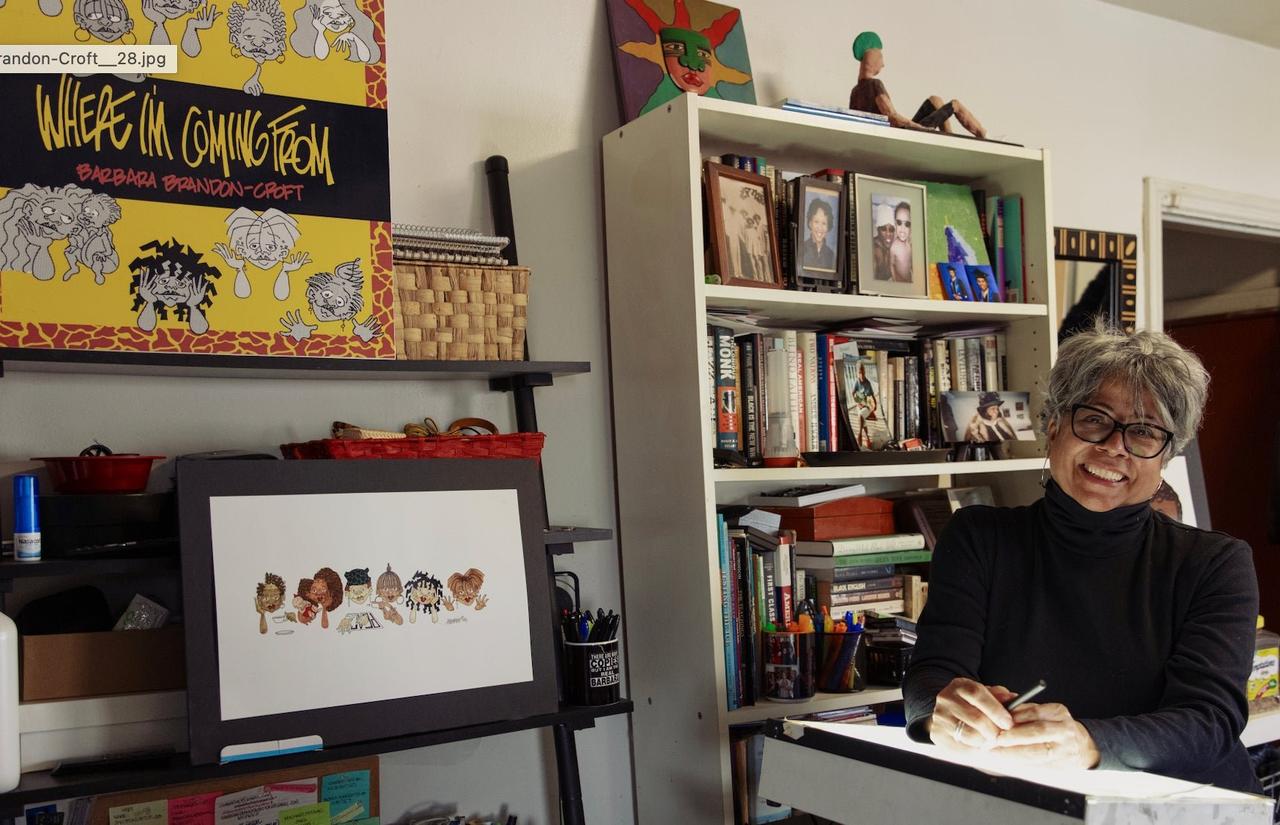If you click on a link and make a purchase we may receive a small commission. Read our editorial policy.
Reconnecting with the landmark comic strip Where I'm Coming From
Cartoonist Barbara Brandon-Croft reflects on her impact as the first Black woman to be syndicated in the mainstream press.

In 1991, Barbara Brandon-Croft made history as the first Black woman cartoonist to be nationally syndicated in the mainstream press with the publication of Where I'm Coming From through Universal Press Syndicate. The comic features a rotating cast of nine Black women. In their conversations with each other and directly with the reader, characters Cheryl, Nicole, Jackie, Lydia, Judy, Alisha, Lekesia, Monica, and Sonya provide social commentary on a wide range of universal topics including friendships, dating, workplace microaggressions, single parenthood, police brutality, reproductive rights, health and fitness, and more.

Brandon-Croft originally developed Where I'm Coming From in 1981 for a magazine for Black women called Elan. Unfortunately, the magazine folded before it could debut. It wasn't until 1989 that the comic would officially publish, as a weekly in the Detroit Free Press. The milestone prompted Brandon-Croft to pursue national syndication, which she did using a self-made media kit and a pitch letter that opened with the headline, "Few Black Cartoonists have entered national syndication since the 1970s – None have been Black Women."
"We all gain from the Black experience," wrote Brandon-Croft in the 1989 pitch letter, which is included in Where I'm Coming From, her new book of collected works published by Drawn & Quarterly in February 2023. "Moreover, everyone's to gain from the Black female experience in particular."
The rest, as they say, is history and doubly so: Brandon-Croft and her father, the late cartoonist Brumsic Brandon, Jr., are the first father and daughter cartoonists to be nationally syndicated through different mainstream syndicates—Brandon, Jr.'s comic strip Luther was first syndicated by Newsday Specials, followed by the Los Angeles Times Syndicate.
In this interview, we check in with Brandon-Croft to learn more about the making of her groundbreaking strip, which was syndicated from 1991–2005, and how she feels about new audiences connecting with the women of Where I'm Coming From.
This interview has been edited for length and clarity.
How did you develop the style of Where I'm Coming From?
When I started out, it was just floating heads. It was going to be a different woman for each strip because it was originally for a [monthly] magazine–it was going to be 12 strips in a year. I grew it from that idea of them talking directly to the reader face-to-face. Talking straight. I liked that. Even when the characters talked to each other, I liked the front-on face because you could read their expressions.
Over the life of the cartoon, the strip layout subtly changed from unmarked panels to blocked, though not separate, panels. Was that something you chose to do just because or based on feedback?
It was my own decision. I started playing with it because I was struggling to get all the words I wanted to get in around the characters. But it was Lee [Salem, Universal Press Syndicate Editorial Director] who said to push the envelope a little further. 'Don't just talk about relationships. You can talk about race and sexism.' He was very encouraging. I was grateful for that.

You credit your dad for immersing you in cartooning and illustration, having grown up laying zipatone for his comic strip Luther, even inking some of his cartoons. Did he also influence your writing?
I was aware from him that your last panel is the punch line and that's where you're going to say something. But the conversations themselves–they were very much conversations that I would have with my friends. They came from a place of real women. My dad's strip didn't include many women's points of view, and here I was doing only women characters.
What was your process for creating each strip?
I would write the idea, 'This is what I want to talk about. This is the little twist I think I need to use.' And then I'd go back and try to make a dialogue meet the end, and I would think about who would be having this dialogue and how it would fit in the overall space. I'd be mindful of if I said that through Cheryl, she'd probably have a little more of an edge to her, or Alisha would be very soft about getting there. So, writing first, and then trying to decide who was going to be in it, and writing their dialogue to get to the punch line.
Self-publishing nowadays, particularly in comics, is very accessible digitally with social media, and you've done it yourself on Instagram since 2016.
I was very happy that I asked [Drawn & Quarterly] if they could put some in [the new book]. They absolutely wanted to do Where I'm Coming From during the syndicate years, and I was like, 'Can we do some of the ones that I've been doing since?' and they agreed to it. That's two spreads–16 new strips–that I have in there! I found that people were interested in what these characters might be into now, might be talking about now, and might be feeling now. That really worked out well for me.

It's great to see because self-publishing is a way to give yourself permission to put your work and thoughts out there just as they are.
Often I'm asked 'What would you tell your younger self?,' and my feeling is I wish my younger self would tell me what to do right now. I was so bold! I was so sure of myself. I was a go-getter. I like the idea of revisiting that old girl and listening to her. Because here I am again, getting attention. And I'm gonna grab it, you know?
How does today's comic strip landscape feel compared to when you pitched Where I'm Coming From to syndicates in 1989?
It's a whole other world now. When I was at CXC [last year], a high school asked me if I could come speak to a class, and I did, and I was glad to, but I found myself trying to explain newspapers–the importance of newspapers and the importance of comics in newspapers. It was interesting to me how I had to go there because right now everything's on a screen.
You've acknowledged that you stand on the shoulders of cartoonists like your dad and Jackie Ormes. What's it like knowing that your work influenced cartoonists like Bianca Xunise and Ebony Flowers, each of whom provided blurbs for your book?
They tell me that it was seeing my stuff that made them think that they could do this. I had the luck of having a role model in my house, so I know what it takes. If you can see somebody do something, then you can believe that you can do it as well. Being told that I've encouraged or inspired people–that's a great feeling.
Between STILL…Racism in America: A Retrospective in Cartoons, your exhibit developed with Tara Nakashima Donahue that most recently showed at the Billy Ireland Cartoon Library and Museum, and your book Where I'm Coming From with Drawn & Quarterly, what's it mean to you that your comics are finding new audiences?
The reaction I'm getting is so incredible, that people still get it all these years later. It's thrilling to know that I can reach a whole other generation. A woman told me her 13-year-old daughter said, 'This is really good.' That makes my heart swell.
Where I'm Coming From is available for purchase now from Amazon, Bookshop.org, and Barnes & Noble.
Follow Popverse for upcoming event coverage and news
Find out how we conduct our review by reading our review policy
Let Popverse be your tour guide through the wilderness of pop culture
Sign in and let us help you find your new favorite thing.
















Comments
Want to join the discussion? Please activate your account first.
Visit Reedpop ID if you need to resend the confirmation email.